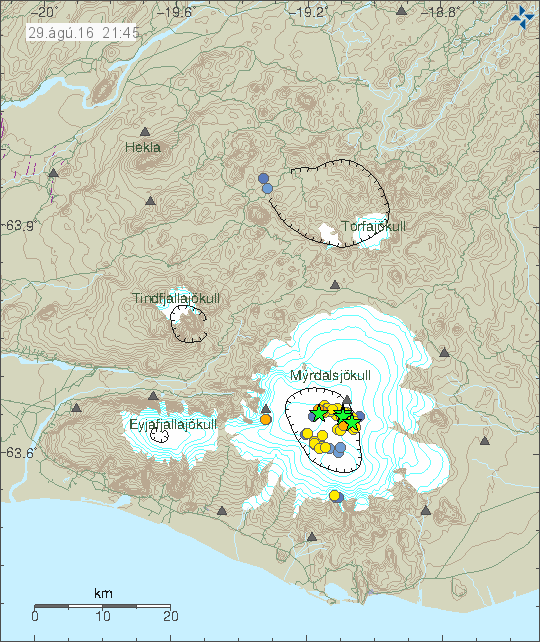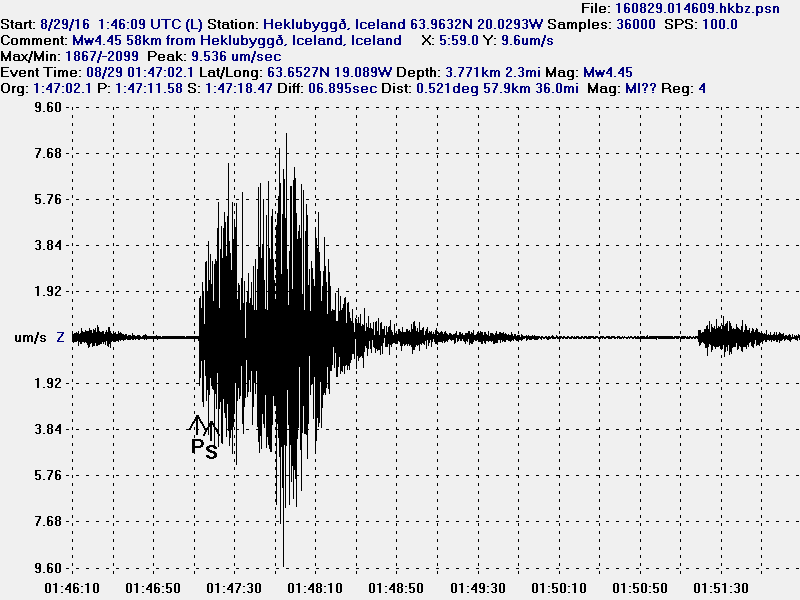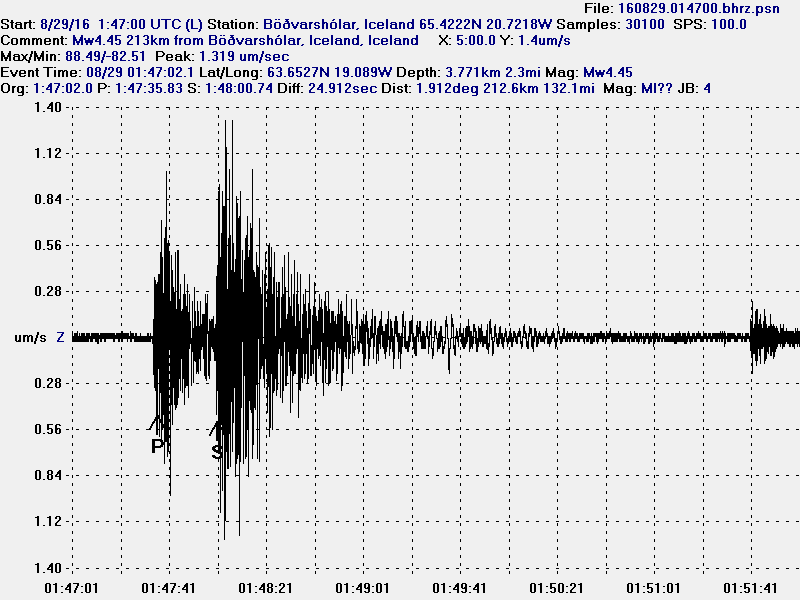This is not going to be a too long update about the activity in Katla volcano. Since I fear that this article might become outdated rather quickly.
Currently there is no eruption in Katla volcano. At the moment only earthquake activity has happened. Latest information shows that hydrothermal water has entered Múlakvísl glacier river from Mýrdalsjökull glacier and that is making the air nearby possibly toxic and dangerous. The two largest earthquakes had the magnitude of 4,5. One earthquake had the depth of 3,8 km while the one that happened 20 seconds later had the depth of 0,1 km. Other earthquakes had magnitude around 3,0 and above and below.

Green star show where earthquakes with magnitude above 3,0 took place in Katla volcano. Copyright of this image belongs to Iceland Met Office.
It is not know how and eruption starts in Katla volcano, since no historical recordings exist when last eruption took place in the year 1918. Making ideas on how an eruption in Katla volcano start mostly guesswork. Current earthquake activity is the strongest since 1977, in 1955 there was some strong earthquake activity but magnitude of those earthquakes is not known. It is my idea that Katla volcano erupts when a rift zone activity takes place in this area, since it is on the eastern volcano zone (EVZ) in Iceland, it is currently expanding south of Vestmanneyjar and American plate and Euroasian plate is around 1cm/year.

The main 4,5 earthquake in Katla volcano. This image clearly shows a long period earthquake. This is my station in Heklubyggð. This image is under CC Licence, please see CC Licence page for more details.

The main 4,5 earthquake as it appeared on my geophone in Böðvarshólar. The earthquake signal is clear. This image is under CC Licence, please see CC Licence page for more details.
It is difficult to know what happens now. The signs are not good, but Katla is an active volcano with regular eruption cycles so this is only matter of time now. As mentioned above, the reason is lack of data on how the eruption process starts in Katla volcano. All that can be done now is to wait and see what happens next.

Exciting times, Jon, exciting times. Thank you for keeping us up to date, I think you are going to be a busy lad!
Lets see and wait it would be a great surprise for me to erupt
TMI
🙂
I’m not sure if I want to see you erupt Giorgos!?
But it will be a bigger surprise then Katla, that’s for sure…
Could it be that the tremor is going up a little? Is that water?
http://hraun.vedur.is/ja/oroi/mid.gif
It’s wind it seams…
Thank you for this article. Information in German can be found on my blog:
http://www.lukas-gawenda.de/erdbeben-am-vulkan-katla-auf-island/
Veðurstofa Íslands @Vedurstofan 30s30 seconds ago Iceland
Glacial water flowing in Múlakvísl river S of Mýrdalsjökull. Gas measurements show high concentrations of sulfur dioxide & hydrogen sulfide
The reviewed table show two separate E’Q’s of ML4.5, the one of Jon above and a shallow one at 100 meters, some 26 seconds later. As mentioned in http://icelandgeology.net/?p=1397 (about the ML3.2 E.Q) it is a single Q, mirrored by something and thus fooling the SIL stations?
Time for a pint.
This where two earthquakes, the signal get mixed at more distance as can be seen on my recording from Böðvarshólar.
It looks a bit like they’re on top of each other….
Isn’t there a constant outflow of water from the periphery of the glacial systems on Katla?
Are we seeing temperature and acidity flux there at all?
How much doming has occurred?
Fun times ahead!
No, they tend to build up and then flood the nearby glacier rivers. Over the summer there is a melt from the surface of the glacier rivers that goes into the glacier rivers.
I’m not very good at reading GPS data, but surely there are signs of rapid “swelling” at Austmannsbunga since late July/early August?
Forgot the link…
http://strokkur.raunvis.hi.is/~sigrun/AUST_rap.png
3.8 EQ at Bárðarbunga. What is that?
Where does the sulfur og hydrogen sulfide in the river come from if there hasnt been a small eruption?
The area under the glacier is full of hydrothermal areas, or hot springs as they are sometimes called.
The theory of rift zone activity would seem to be a sound one, as it seems like there has been a bit of a “release” of energy from movement along the whole line, from Grimsey to Reykanes this summer, and a corresponding rumble from Katla.
And while I know that when Eyjaf wakes, the motto is that Katla usually does too, but does that work in reverse? If Katla goes, is there historical data to suggest that Eyjaf may folow?
Activity in one area of the rift zone does not equal activity in other parts of it. Why that is I don’t know. But that is just the reality as it is.
New power supply in my main earthquake computer. I’m hoping for better run of it now. Since I was using power supply that was slightly too small for the motherboard and the cpu (350W). Upgraded to 500W power supply.
So is your earthquake computer generating eartquakes? I doubt 500W is enough 🙂
I use to record earthquakes. You can view the result here.
http://www.jonfr.com/webicorders/tremoren.htm
Tuesday
30.08.2016 16:48:48 65.036 -16.840 0.9 km 3.2 62.08 11.0 km W of Dreki
Tuesday
30.08.2016 16:56:33 64.668 -17.422 3.2 km 3.4 99.0 5.9 km ENE of Bárðarbunga
As posted earlier on by an ever active commentator (amongst others): E.Q.’s Katla June-August time laps suggesting a ring vault oriented event http://vatna.carto.com/viz/2c9d8c08-c2b6-4efa-afad-d4f0b078b025/public_map
Ring Fault
will it be any new article for the Vatnajokull swarms?
Yes, I just need to get me some food before I write it.
Caldera Kolaps Earthquarks. Bardarbunga is dead. 🙂
Yeah right….LOL Earthquakes equal energy equal very much alive!;)
But Not magmatisch !!!!!
Seismologist Martin Hensch at the Icelandic Met Office told mbl.is that between ten and 15 aftershocks followed the quake. He stated this is likely a case of movements in the edge of the caldera but not movements of magma. From Today Lol
Update (German):
http://www.lukas-gawenda.de/erdbeben-am-vulkan-katla-auf-island/
A 3.5 quake was recorded today: http://en.vedur.is/earthquakes-and-volcanism/earthquakes/myrdalsjokull